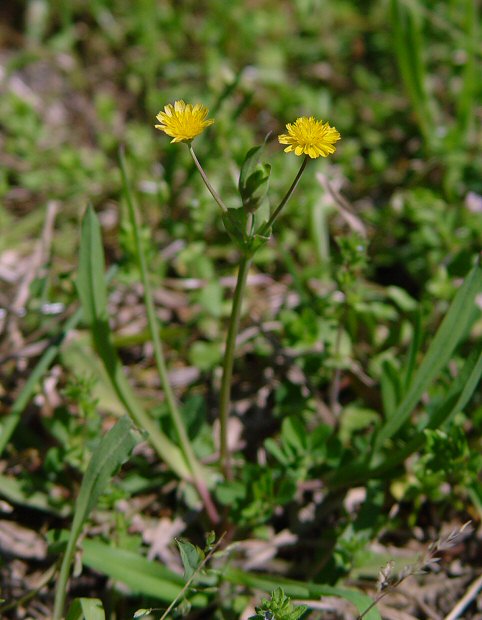Krigia cespitosa (Raf.) K.L. Chambers
Common Dwarf Dandelion

Native
CC = 2
CW = 3
MOC = 41
© DETenaglia
Krigia cespitosa (Raf.) K.L. ChambersCommon Dwarf Dandelion | |
 |
Native CC = 2 CW = 3 MOC = 41 |
© DETenaglia |
|
Family - Asteraceae/Cichorieae Habit - Annual forb with fibrous roots. Stems - Loosely ascending to erect, to 45 cm, sometimes multiple from a spreading base, with few to several ascending branches, glabrous or rarely sparsely to moderately pubescent toward the branch tips with spreading, gland-tipped hairs, often glaucous, with white milky sap.
Leaves - Basal and alternate, the uppermost few sometimes appearing opposite, the basal leaves often with short to long, winged petioles, the stem leaves mostly sessile with rounded, clasping bases. Leaf blades 1-15 cm long, linear to narrowly oblanceolate, the first rosette leaves sometimes ovate, entire, wavy, toothed, or shallowly to deeply pinnately lobed, the teeth or lobes spreading, oblong and rounded or triangular and pointed, the leaf tip rounded to more commonly pointed, the surfaces glabrous, often glaucous.
Inflorescence - Terminal umbellate clusters. Flowers on stalks to 5 cm long, glabrous below, with glandular hairs at the apex below the involucre.
Heads - Ligulate. Receptacle convex, naked. Involucre to 5mm long, 6mm broad (in fruit), smaller in flower, cupulate. Phyllaries 4-7 in 1-2 series, 2-5 mm long, lanceolate to ovate or oblong-ovate, becoming somewhat keeled as the fruits mature, glabrous.
Florets - Ligulate florets 12-25. Corollas 3-7 mm long, light yellow to yellow. Pappus absent.
Fruits - Achenes 1.4-1.7 mm long, narrowly obovoid, more or less circular in cross-section, with usually 15 ribs, these minutely roughened or barbed, reddish brown, glabrous. Pappus absent.
Flowering - April - June. Habitat - Prairies, glades, fens, forest openings, pond margins, sloughs, pastures, fields, lawns, cemeteries, railroads, roadsides, sandy open alluvial ground, and open, disturbed areas. Origin - Native to the U.S. Lookalikes - Other species of Krigia, especially K. virginica and K. occidentalis; more broadly, many members of the Cichoreae tribe of the Asteraceae, including the common dandelion. Other info. - This little species is found in a number of scattered counties, mostly south of the Missouri River. Beyond Missouri its range extends throughout most of the southeastern quadrant of the continental U.S. It is fairly easy to identify by its small yellow flowering heads, which typically occur in umbel-like clusters, and smooth, straplike basal leaves which tend to be glaucous. An excellent additional clue is the lack of a pappus, which contrasts with most other members of the family and all other members of the Krigia genus. The seeds are thus missing the fluffy tufts so characteristic of dandelion "seeds" (for example). Photographs taken in Van Buren, MO., 5-28-04, and in Hunter, AL., 4-3-05 (DETenaglia); also at Canaan Conservation Area, Gasconade County, MO, 5-5-2016, and Pacific Palisades Conservation Area, MO, 5-18-2019 (SRTurner). |